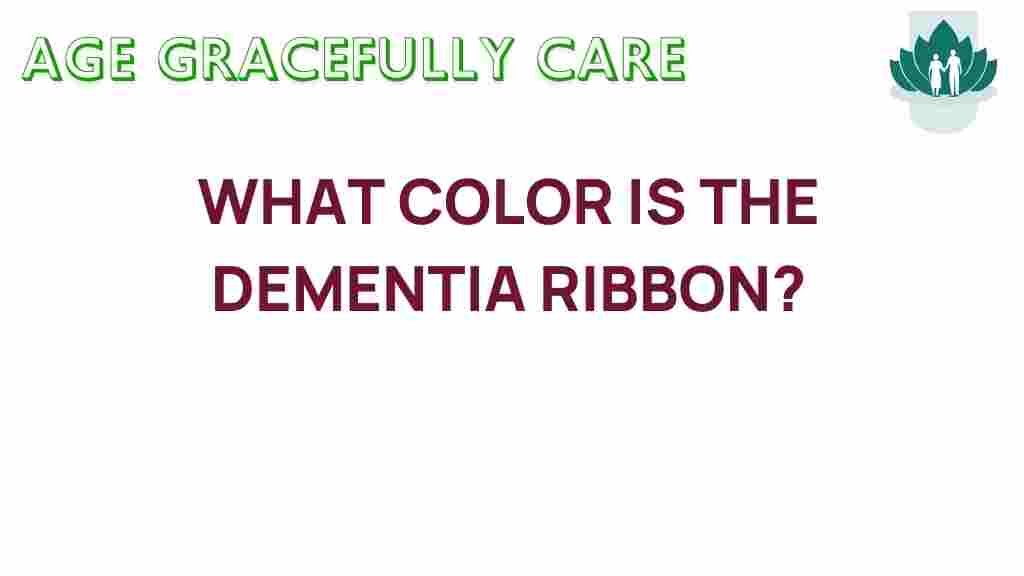Dementia Ribbon: Understanding the Color Representing Dementia Awareness
Dementia is a growing concern in our society, affecting millions of individuals and their families worldwide. As we strive to raise awareness and advocate for better mental health resources, it becomes crucial to understand the symbols associated with dementia. One of the most recognizable symbols is the dementia ribbon, which plays a vital role in advocacy and awareness campaigns. In this article, we will explore the meaning behind the dementia ribbon, the significance of its color, and how you can contribute to dementia awareness.
The Significance of the Dementia Ribbon
The dementia ribbon serves as a powerful emblem that unites individuals, families, and communities in the fight against dementia. It symbolizes not only the struggles faced by those living with dementia but also the hope for research, understanding, and better care. The color associated with dementia awareness is purple, which is widely recognized and used in various campaigns around the world.
Color Symbolism in Dementia Awareness
Color symbolism plays a significant role in how we perceive various causes. For dementia awareness, purple represents a blend of red and blue, symbolizing passion and calmness. This duality reflects the emotional rollercoaster faced by caregivers and loved ones affected by dementia. Here are some ways purple is interpreted in the context of dementia:
- Compassion: Purple represents the compassion needed to support those living with dementia.
- Awareness: The vibrant hue stands out, making it an effective color for raising awareness.
- Hope: Purple is often associated with hope and the potential for improved treatments and understanding of dementia.
Steps to Promote Dementia Awareness Using the Dementia Ribbon
If you’re looking to make a difference in dementia awareness, here are some steps you can take to advocate for this important cause:
1. Educate Yourself and Others
Understanding dementia is the first step in advocacy. Here are some resources to help you:
- Visit the Alzheimer’s Association website for comprehensive information.
- Read books and articles that detail personal experiences and scientific research.
- Attend local workshops or seminars focused on dementia education.
2. Wear the Dementia Ribbon
Show your support by wearing the dementia ribbon. Here’s how it can help:
- Start conversations about dementia.
- Encourage others to join the cause.
- Use social media to share your support, using hashtags like #DementiaAwareness.
3. Organize or Participate in Events
Many organizations host events to raise awareness for dementia. Consider the following:
- Participate in walks or runs that promote dementia awareness.
- Host a local event in your community to inform others about dementia.
- Fundraise for research initiatives or local support groups.
4. Advocate for Policy Changes
Policy advocacy is crucial for improving mental health resources related to dementia. Here’s how you can get involved:
- Contact local representatives to discuss dementia-related issues.
- Support legislation aimed at improving care for dementia patients.
- Join or support organizations that focus on dementia advocacy.
Personal stories can have a profound impact. Consider sharing your journey with dementia:
- Write a blog post or article about your experiences.
- Participate in speaking engagements to raise awareness.
- Use social media platforms to tell your story and connect with others.
Troubleshooting Common Challenges in Dementia Advocacy
While advocating for dementia awareness is rewarding, you may encounter challenges along the way. Here are some common issues and tips to overcome them:
1. Lack of Awareness
Many people may not understand what dementia is or its impact. To combat this:
- Use clear and simple language when explaining dementia.
- Share informative graphics and statistics that illustrate the issue.
- Encourage discussions in community settings to raise awareness.
2. Emotional Challenges
Advocating for dementia can be emotionally taxing, especially if you have a personal connection to the disease. Here’s how to manage:
- Practice self-care regularly to maintain your mental health.
- Join support groups to connect with others who share similar experiences.
- Consider professional counseling if needed.
3. Limited Resources
Finding resources for advocacy can sometimes be a challenge. To address this:
- Connect with local organizations that focus on dementia.
- Utilize online platforms for resource sharing and collaboration.
- Reach out to established advocacy groups for guidance and support.
Conclusion: The Power of the Dementia Ribbon in Advocacy
The dementia ribbon is more than just a piece of fabric; it embodies a movement towards greater understanding and support for those affected by dementia. By wearing the dementia ribbon, educating ourselves and others, and actively participating in advocacy efforts, we can make a significant impact on dementia awareness. The color purple will continue to shine brightly as we unite in our efforts to promote mental health and support for those battling this challenging disease.
As we move forward, let us remember the importance of compassion, education, and policy advocacy in the fight against dementia. Every action counts, and together, we can create a future where dementia awareness and care are prioritized. For more on mental health advocacy, visit Mental Health America and discover how you can get involved.
This article is in the category Health and created by AgeGracefullyCare Team
